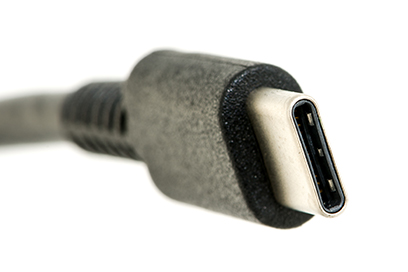อะไรคือ USB Type-C?
ในสมัยนี้ทุกช่องรับ USB มีอยู่ในทุกๆหนทุกๆแห่ง ไม่ว่าจะเป็น ในรถ ในเรือหรู หรือแม้กระทั้งในเครื่องบิน
และเราก็จะสามารถเริ่มเห็นช่องรับ USB ในเครื่องใช้ high−end ต่างๆ ราวกับว่าไม่มีสิ่งใดที่ รูเล็กๆนี้จะไม่สามารถทำได้ ตั้งแต่ส่งต่อข้อมูล ชาร์ตไฟ และในทุกวันนี้คุณก็สามารถซื้อ USB Switchers แทน USB “octopus” cable hubs ที่จะทำหน้าที่ราวกับ ตัว KVM (keyboard/video/mouse) ในสินค้าประเภทภาพและเสียงประเภทต่างๆ
กับ USB 3.0 ที่จะสามารถทำงานได้รวดเร็วมากกว่า USB 2.0 (ที่สามารถส่งสัญญาณสูงสุดได้ไม่เกิน 5 GB/s) กับความเร็วที่เรียกได้ว่าสูงจนอาจก่อให้เกิดการรบกวนการทำงานของสัญญาณ 2.4 GHz Wi−Fi ที่นิยมใช้ในการเชื่อมต่อ Smartphones and tablets (และนี่ก็เป็นหนึ่งในเหตุผลที่คุณยังไม่เห็น USB 3.0 ในอุปกรณ์เหล่านั้น!)
ด้วยสเป็กใหม่ที่จะออกมา กับหัว 24 pin Type−C ที่จะมีขนาดเล็กกว่า หัว Type−A ที่กำลังเป็นที่นิยมอยู่ในทุกๆวันนี้ และที่สำคัญมันถูกออกแบบมาให้สมมาตรกัน! ทำให้เสียบยังไงก็ถูก ต่อจากนี้ไปคุณก็จะหมดปัญหาที่จะต้องใช้เวลายาวนานพยายามที่จะเสียบสาย Micro USB ให้ถูกด้าน
USB 3.0 ยังมีคุณสมบัติพิเศษอื่นนอกจากการเชื่อมต่อที่สามารถทำได้เร็วขึ้น แตกต่างจากสเป็นปัจจุบัน USB 3.0 สามารถส่งไฟ 100 watts ได้ในทั้งสองทิศทาง ที่จะช่วยส่งข้อมูลได้อย่างรวดเร็วยิ่งขึ้นไปอีก กับ USB 3.1 ตัวใหม่ล่าสุดที่สามารถส่งข้อมูลได้เร็วมากถึง 10 Gb/s ที่ควรเร็วพอๆ หัวThunderbolt รุ่นแรกๆ
กลับมาที่เรื่องของการเชื่อมต่อ ทั่วโลกเริ่มหันมาสนใจหัว Type−C ก็เพราะ Type−A เริ่มถูกมองว่าเป็นหัวที่ใหญ่เกินไปสักหรับมือถือที่แทบจะบางลงเรื่อยๆในทุกๆวันนี้ แต่อีกประเด็นที่สำคัญของเทรนด์ความนิยมที่กำลังจะเกิดขึ้นของหัว Type−C นั้น ไม่ได้มาจากเพียงแค่เพราะขนาดหัวที่เล็กลง แต่มันเกิดขึ้นจากความสามารถที่ทำได้รอบด้านของหัว Type−C นี้
อีกหนึ่งความสามารถที่สุดเท่ของหัวType−C ที่ไม่พูดถึงเลยไม่ได้คือ หากคุณเสียบหัวด้านหนึ่งของ Type−C เข้ากับแล็ปท็อป และอีกด้านของสาย HDMI ไปยังหน้าจอแสดงผล แล็ปท็อปของคุณจะสามารถแยกแยะการทำงานว่าตอนนี้เรากำลังอยู่ในโหมดแสดงผล โดยมันจะสามารถปรับหน้าที่การทำงานให้สอดคล้องกันได้อย่างรวดเร็ว และหากคุณดึกปลั๊กออกมา และนำมันไปเสียบยังปลั๊กไฟหละ? ทันที่ทันใดมันจะจะแปลงร่างการเป็นสายชาร์ตให้คุณ
และนี่เราอาจจะกำลังพูดถึง USB ที่กำลังจะเข้ามาแทบที่ปลั๊กทั้งหมดที่เราใช้ๆกันอยู่ในปัจจุบันนี้
คุณลองนึกภาพ USB Type−C เข้ามาแทนที่การใช้งาน USB Type-A Mini ที่ยังมีการใช้อย่างแพร่หลายไม่ว่าจะเป็นในเครื่องปริ้นหรือเครื่องสแกนต่างๆ และหัวหน้าตาคล้ายๆกันที่ยังพบได้ในมือถือละกล้องถ่ายรูปของคุณ
ลองคิดดูนะคะว่าชีวิตเราจะง่ายขึ้นสักเพียงใด
Credit : http://k.kramerav.com/blog/post.asp?pid=1359
Face it: You know the USB connector has gone mainstream when it starts appearing in cars. Just about every model sold today (trucks and SUVs, too) has at least one if not two USB ports in it. And most of the time, drivers and passengers use them to charge their smartphones, occasionally playing music or uploading a contact list for hands−free calling. (In case you hadn’t noticed, USB connectors are showing up in airplanes, on newer cruise ships, and on trains, too!)
The USB port has become so ubiquitous that it’s even starting to appear on high−end connected appliances. There’s not a whole lot that this versatile data/power connection can’t do, and you can now buy USB switchers – basically, spiffed−up versions of the old USB “octopus” cable hubs, but with individually−selected outputs for things like switching KVM (keyboard/video/mouse) ports in AV applications.
Now, there’s a new version of USB coming to town – 3.0. It runs a lot faster than 2.0 (maximum data rate in excess of 5 GB/s) with a correspondingly higher clock speed; one that is high enough to actually create interference with 2.4 GHz Wi−Fi connectivity in smartphones and tablets (which is why you don’t see USB 3.0 on those gadgets yet!).
With a new specification comes a new connector, the 24−pin Type−C plug. It’s a lot smaller than the older Type−A plug we’re used to, and it also features a symmetrical, reversible design – you can plug it in either way, and it will still work. (We just heard a big cheer from all of you who spend minutes trying to figure out which way to plug in your Micro USB connector and charge your phone at 11:30 PM!)
There’s more to USB 3.0 than just a faster connection, though. Unlike the current specification, USB 3.0 can deliver up to 100 watts of power, in either direction, which simultaneously streaming serial data. The latest extension of the standard − USB 3.1 – ups the data streaming rate to 10 Gb/s, about what first−generation Thunderbolt (PCI−X over DisplayPort) could handle.
Back to the connector. Type−C came into being because Type−A is too large for mobile devices and ultra−slim notebooks. Ultimately, it will replace the Type−A connector completely, and that’s not just because it’s a small, reversible connector.
The USB 3.0/3.1 specification also creates what’s known as an Alternate Mode. In short, you can use some or all of the pins on a USB Type−C plug to carry display data, turning your USB connection into a display connection. VESA’s DisplayPort 1.3 connector and Lattice’s superMHL plug were the first to support Alternate mode through USB Type−C, and HDMI recently joined the fun in early September.
That’s a lot of stuff to jam into any connector, let alone one this small!! Yet, this is the way the world of interfacing is headed; getting rid of all the unique, incompatible plugs and jacks we relied on for so many years with our computers, televisions, and personal electronics. If a manufacturer of thin laptops, phones, and tablets hasn’t gone completely wireless yet, chances are the connector of choice on their latest gadgets will be USB Type−C.
Perhaps the coolest feature of Type−C is that it is a “smart” connector. If you plug one end into a USB port on your laptop and the other into an HDMI connector on your display, the laptop interface will know things are operating in display mode and configure the port accordingly. Yank that plug out and tie it up to a wall transformer, and bingo – you’re in charging mode.
In Alternate Mode, the source and display resolution will determine how many pins are to be used on the connector. With HDMI, version 2.0is supported (3840x2160p/60, 8−bit RGB color), and with DisplayPort, you can up that to 10−bit 4K. Higher versions of DisplayPort and the relatively−new superMHL interface standard also use Display Stream Compression, which means you can push an 8K signal (7680x4320 pixels) at 60 Hz through that same Type−C plug. (So many pixels, so little space…)
And there you have it – perhaps the USB plug to end all plugs. USB Type−C can replace Type−A, Mini (still used a lot on printers and scanners), and the two different “micro” versions found on phones and cameras. That would simplify things considerably, wouldn’t it−
And now you know…



